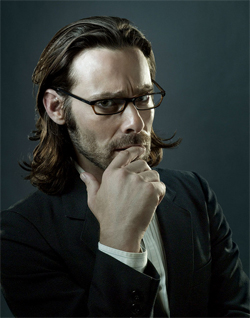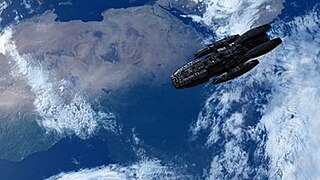
Dr. Gaius Baltar is a fictional character in the TV series Battlestar Galactica played by James Callis, a reimagining of Lord Baltar from the 1978 Battlestar Galactica series. He is one of the show's primary characters.

Karl C. Agathon is a fictional character on the re-imagined Battlestar Galactica TV series, portrayed by Tahmoh Penikett.

Battlestar Galactica is an American military science fiction television series, and part of the Battlestar Galactica franchise. The show was developed by Ronald D. Moore and executive produced by Moore and David Eick as a re-imagining of the 1978 Battlestar Galactica television series created by Glen A. Larson. The pilot for the series first aired as a three-hour miniseries in December 2003 on the Sci-Fi Channel, which was then followed by four regular seasons, ending its run on March 20, 2009. The cast includes Edward James Olmos, Mary McDonnell, Katee Sackhoff, Jamie Bamber, James Callis, Tricia Helfer, and Grace Park.

John Cavil is a fictional character and the main antagonist from the re-imagined Battlestar Galactica television series. He is portrayed by Dean Stockwell. In the fourth-season episode "Six of One", Cavil's model number was revealed as Number One.
"Act of Contrition" is the fourth episode of the reimagined Battlestar Galactica television series.
"Colonial Day" is the eleventh episode of the reimagined Battlestar Galactica television series.

"Valley of Darkness" is the second episode of the second season of the reimagined Battlestar Galactica television series. It aired originally on the Sci Fi Channel on July 22, 2005.

"Fragged" is the third episode of the second season of the Battlestar Galactica television series. It aired originally on the Sci Fi Channel on July 29, 2005. It is the first episode in which Starbuck does not appear.

"The Farm" is the fifth episode of the second season of the reimagined Battlestar Galactica television series. It aired originally on the Sci Fi Channel on August 12, 2005. It is the first episode of the series in which the plot is set on Caprica.

"Home" is a two-part episode of the reimagined Battlestar Galactica television series. Part 1 aired originally on the Sci Fi Channel on August 19, 2005, and Part 2 aired on August 26, 2005.

"Pegasus" is the tenth episode of the second season of the reimagined Battlestar Galactica television series. It aired originally on the Sci Fi Channel on September 23, 2005. Following "Pegasus", the series went on hiatus until January 2006.

"Resurrection Ship" is a two-part episode of the reimagined Battlestar Galactica television series. Part 1 aired originally on the Sci Fi Channel on January 6, 2006, and Part 2 aired on January 13, 2006. It was the first episode broadcast after a hiatus following the broadcast of the previous episode, "Pegasus", on September 23, 2005.
"Epiphanies" is the thirteenth episode of the second season of the reimagined Battlestar Galactica television series. It aired originally on the Sci Fi Channel on January 20, 2006.
"Lay Down Your Burdens" is the two-part second-season finale of the reimagined Battlestar Galactica television series. Part 1 aired originally on the Sci Fi Channel on March 3, 2006; Part 2 aired on March 10, 2006, as a 90-minute special.
The music of the 2004 TV series Battlestar Galactica is a body of work largely credited to the composers Bear McCreary and Richard Gibbs. The music of Battlestar Galactica displays a variety of ethnic influences and generally does not conform to the "orchestral" style of many science fiction scores.
"A Disquiet Follows My Soul" is the twelfth episode in the fourth season of the reimagined Battlestar Galactica. It aired on television in the United States and Canada on January 23, 2009, in Australia on January 31, 2009, and on Sky One in the UK on January 27, 2009. According to the director, this episode takes place immediately after the webisode series "The Face of the Enemy". The survivor count shown in the title sequence is 39,644. The Region 1 DVD release of Season 4.5 includes an extended version of this episode.

"Daybreak" is the three-part series finale of the reimagined science fiction television series Battlestar Galactica, and are the 74th and 75th episodes overall. The episodes aired on the U.S. Sci Fi Channel and SPACE in Canada respectively on March 13 and March 20, 2009. The second part is double-length. The episodes were written by Ronald D. Moore, and directed by Michael Rymer. The Season 4.5 DVD and Blu-ray releases for Region 1 feature an extended version of the finale, which not only combines all three parts as a single episode, but also integrates it with new scenes not seen in the aired versions of either part. The survivor count shown in the title sequence for Part 1 is 39,516. The survivor count shown in the title sequence for Part 2 is 39,406. At the end of Part 2, Admiral Adama announces the survivor population at approximately 38,000.

Laura Roslin is a fictional character in the reimagined Battlestar Galactica series. Played by Mary McDonnell, she is the President of the colonies and a key character throughout the series. The character is noted in part for a realistic moral complexity and nuance.
This is a bibliography of works about the Battlestar Galactica franchise. It does not include fictional works.












